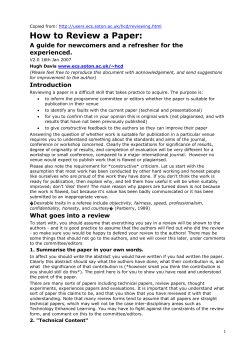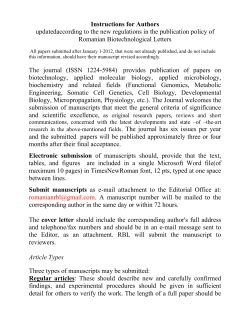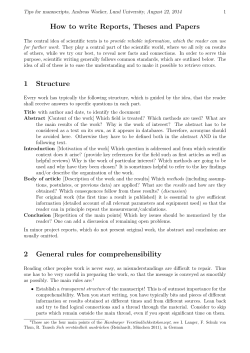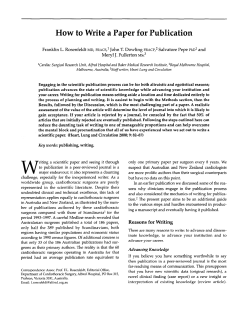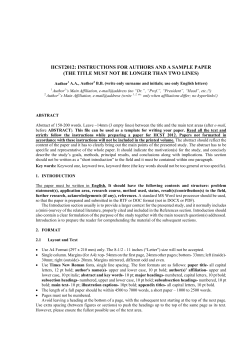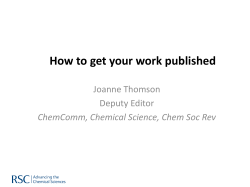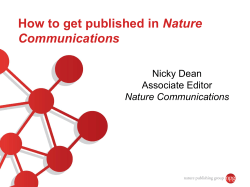
HOW TO WRITE A SCIENTIFIC ARTICLE FOR A MEDICAL JOURNAL? SUMMARY
21 KOTUR TO 2002; WRITE SCIENTIFIC ARTICLE Indian J.: HOW Anaesth. 46A(1) : 21-25 EDUCATION FORUM HOW TO WRITE A SCIENTIFIC ARTICLE FOR A MEDICAL JOURNAL? Dr. P. F. Kotur1 SUMMARY Writing for a medical journal is an exciting moment because it represents the outcome and recognition of an ardous process. Only through a clear and through writing can a research be translated properly to clinical practice for the benefit of the patient community. Writing an article by an author and publishing an article by an editor are both key quality issues. Both of them should know the expectations of each other. The article highlights the guidelines of a good writing so that it won’t be rejected by any journal. “Not all who look at a journal are going to read even one article in it; Writers must know therefore what turns a looker in to a reader” J. W. Howie1 Research is essential for the growth and development of any medical science. Only through sound, scientific and educational research can new and old ideas get tested, thus guarding against stagnation and dogmatism, In order to achieve its goal of becoming useful to the community, the research has to he translated and applied to the patients in the day today clinical practice. The challenge faced by the practising physician today is to provide up to date medical care to his patients by incorporating the valid, new information-2 The role played by the scientific articles in the translation of research into clinical practice need not to be emphasized as it is the only available path for the up date of any speciality. There has been a dramatic increase in the numbers of medical journals published in the last one decade and there has been an increasing demand for the scientific articles. Every year 6 million scientific medical articles get published. Despite this gargantuan volume of medical literature, less than 15% all articles published on a particular topic are useful3. Even articles published in the most prestigious journals are far from perfect. Analyses of clinical trials published in a wide variety of journals have described large deficiencies in the design, analysis and reporting. Although improving with time, average quality score of clinical trials during the past 2 decades is less than 50%.4,5,6 The researches thus, must take the 1. M.D.,Prof, HOD of Anaesthesiology JN Medical College & K.L.E.S.H. & M.R.C., Belgaum-590 010., Karnataka, India. personal responsibility of providing a valid, readable, scientific material. Conveying one’s research findings is an exciting moment because it represents the out come and recognition of an arduous process. Clarity in reporting how the research was con- ducted and what results were obtained is paramount both for the research community and for the medical practitioners. Only through clear and thorough writing can the clinicians transfer the benefit of the research to the patients and to fellow researchers eventually to explore the topic one step further. It is through the correctly written article that the clinicians appreciate the concepts being developed and judge the extent to which results can be applied in their setting. The results serve as basis on which clinical actions can be planned and implemented. Thus, a healthy and productive cycle is created between theory and clinical practice:theory-practice-theory7 . Another potent stimulus, rather a compulsion for any body to write a scientific paper is an albeit, misplaced, universal emphasis on ‘publications’ as a criteria of determining competence and suitability for academic positions. Papers written solely for this purpose contribute significantly for the low quality publications. The common deficits found in the articles written in our county are due to poorly planned and conducted research and poorly presented research. A poorly designed and conducted research can never yield a worthwhile paper and therefore due attention must be given to this aspect at the conception stage. It is beyond the scope of this lecture to discuss about how to conduct a good research. Let us assume that a scientifically valid research has been conducted and the aim of this lecture is to highlight the art of presentation of a well conducted study, so that it will not be rejected by any journal. 22 Before going on further discussion on the art of writing, I want all the authors to realise before hand ‘What generally happens to manuscripts submitted to a journal’? For both editorial staff and authors the selection of articles for journal publication is, a key quality issue8. Authors (and readers also) will find it helpful to know how journal articles are selected for publication. Manuscripts submitted to a journal enter a two stage review process. Initially they are read by the editor and assessed for quality, relevance and style. One or more of the associate editors may also read manuscripts as they are received. A small number of articles may be rejected at this stage. Having passed this first scrutiny, manuscripts enter the second phase – peer review. These are the experts who have knowledge, experience and interest in the manuscript topic. The process of editorial review and peer review is confidential and reviewers are reminded of both this and other responsibilities, each time they receive an article. After completion of these stages, manuscripts may be returned to authors with suggestions for improvement through amendment or rejected. Many manuscripts are accepted for publication subject to appropriate amendment. Occasionally papers are returned to authors with a request for revision that does not necessarily guarantee acceptance . Such papers are reassessed before final decisions are made. It is useful for prospective authors to be aware of these steps in the publication cycle, especially those relating to reviewers comments and subsequent amendments. Adhering to the ‘Guide lines for Authors’ greatly speeds up the decision making process. This is a part of the quality assurance cycle of journal publication and usually results in a stronger, more easily read, better organised and better structured paper. Purcell, Donovan and Davidoff (1998) recently reviewed changes made to papers submitted to a leading North American medical journal. They found five types of problems; too much information, too little information, inaccurate information and problems of structure or of organization4. Changes were requested most often because of missing information, particularly in the introduction or conclusions to the paper. In addition to the above problems, as an editor of a medical journal, I find most of the times that the articles written by Indian researchers are deficient both in grammatically correct language, and adequate references in support of the statements made in the article. The latter problem is getting sorted out slowly with easy availability INDIAN JOURNAL OF ANAESTHESIA, FEB. 2002 of a fast, low cost access to the electronic medical literature data base through electronic mail and internet. The decision to accept for publication or otherwise of an article is based upon twin criteria of importance and quality. Other factors those may influence the decision are the page length of an article or recent publication of similar articles. Prologue ‘A well begun is half done’ Author must think before hand, about “How to write?” “What to write?” and “Where to submit?”. Having affirmed all of the above, with the data of a well conducted and concluded research project in hand, author must think of a “clear message” intended to be given through his write up. A good measure of success is the conclusions drawn from the study, if can be written in one meaningful sentence. The others considerations to be decided priorly are i) What is the best format of presentation of the research done? eg: as original article, review, case report, or correspondence,? because format is different for different type of articles. ii) Target audience for the publication and which journal?: Aspiring authors will improve their chance of acceptance if they choose an appropriate journal for their topic and adhere to conventional rules. The reason why this decision must be taken in the early phases is that from the first draft, the paper must be written in the style and format of the specific, journal targeting particular group of audience. iii) A thorough literature search is quite essential : a) to identify the knowledge gaps in the existing information and the proposed paper may be aimed to fill them up. b) to avoid duplication if the same message or project has been published already. Most journals do not wish to consider for publication a paper or work that has already been reported in a published paper. iv) Other matters related to authorship, ethical, and statistical clearance may be obtained well in advance. Useful Hints for Good Writing Editors and reviewers look for brevity, clarity, and validity when reviewing manuscripts. Good and bad papers generally identify themselves. One of the key developments in scientific publication since 1950, has been the wide spread adoption of the IMRAD structure. It is set around four distinct sections : 1) The Introduction (Why did we start)? 2) Methods (What did we do?). 3) Results (What did we find?). 4) Discussion (What does it all mean?). 23 KOTUR : HOW TO WRITE A SCIENTIFIC ARTICLE Apart from this, article also includes Title, Abstract, Keywords, Acknowledgements, and References which again may be remembered by acronym. TAKAR. 2) Ever since the publishing of “Uniform requirements for manuscripts submitted to Biomedical journals” in the year 1979, by the International committee of Medical Journal Editors, (ICMJE), (which is periodically revised by the committee) more than 500 journals including our IJA have accepted and adopted them9 They have agreed to receive manuscripts in accordance with the requirements. It is important to emphasize what these requirements imply and what they don’t; they are available on line www.icmje.org. In addition, the journal’s instructions to contributors are likely to contain other requirements, unique to that journal, such as : number of copies of manuscripts, acceptable languages, length of articles and approved abbreviations. Inspite of all these facilitations, writing a journal article is a demanding exercise and for those whose first language is not English, it is much more difficult. Georges B in the year (1989) presented some 40 factors which he classified under nine headings which follow the usual order of presentations in any journal article, to facilitate the task of preparing a paper for publication7.viz 1) Title 2) Author 3) Abstract and keywords 4) Introduction and Review of literature. 5) Material and Method 6) Results 7) Discussion and conclusion 8) References and 9) General considerations. How I want to proceed further in my lecture is to discuss these 40 factors sequentially under the guidelines of ICJME requirements with special references to Indian scenario. I) Title 1) Title should correctly represent the content and breadth of the study reported and should not be misleading. For example “comparative evaluation of Propofol – Ketamine and Propofol Fentanyl in minor Surgery”. On reading the title, we can not know the content and breadth of the study; whether dosage, duration, efficiency, and sequalae, of two group are studied or not whether they are studied as only induction agents or as sole anaesthetic agents; what group of patients? None of the information can be had from this title. It should be clear, concise, and informative. It should contain keywords, that capture attention of the reader. No abbreviations are used in the title. The decision to read an article often rests on the appeal of its title. A More appropriate title could be –“Comparative evaluation of efficiency of Propofol – Ketamine and Propofol – Fentanyl combination as sole anaesthetic agents in patients undergoing minor ambulatory gynecological operations”. II) Author 3) Designation, degree, affiliation and address of authors are to be clearly indicated, with additional details like telephone number, email address of the corresponding author. III) Abstract & Keywords 4) Abstract should cover each and every component of, the study in 150 words for ‘unstructured’ abstracts and 250 words for ‘structured’ abstracts. It should state the purpose of the study or investigation, basic procedures, (selection of study subjects, methodology, main findings, statistical significance), the principal conclusion and implications. 5) The abstract should contain precise information and should not contain abbreviations. 6) The implications and benefits should commensurate with the results obtained, and are to be highlighted. 7) Key words (or short phrases) 3 to 10, should be listed covering all the aspects of the study. Use preferably the terms listed as Medical subject headings (MESH) in Index Medicus (Medline) IV) Introduction and Review of Literature 8) The goal or purpose of the study is clearly stated. The introduction should contain detailed information about the problem being studied, and about the specific research question/hypothesis. 9) Four or five pertinent publications related to the problem should be presented and critiqued. No data or conclusions are to be reported. 10) Do not review the literature extensively. 11) The pertinence of the study is presented, in relation to the current theories and methods associated with the problem. The existing gaps in the knowledge or conflicting data is to be highlighted. 12) A general overview of the study is presented. Over view serves as organiser for the sections to follow to the reader. 24 INDIAN JOURNAL OF ANAESTHESIA, FEB. 2002 V) Material and Method 13) The selection of the subjects for the study has to be described clearly. Inclusion and exclusion criteria are to be mentioned with method of allocation to groups. 14) The research design is to be described in detail. Research design is the plan that is chosen to answer the research question. The methods, apparatus and procedures are to be identified in sufficient detail to allow other workers to reproduce the results, if necessary. 15) Give references of all the methods used in the study including statistical methods. 16) Identify precisely all drugs and chemicals used, including generic names, doses and routes of administration. 17) Methods of elimination of errors viz blinding, introduction of control group and placebo, randomization etc are to be mentioned distinctly. 18) The measurement instrument including its psychometric qualities is described clearly. The psychometric qualities include validity, reliability, objectivity and precision. An example of the instrument should be gives in the text or in an appendix. For example in the above mentioned study, if ‘home readiness’ is intended to be studied, the ‘Post Anaesthetic Discharge scoring system’ (PADS) utilised in the study has to be a reliable, and an accepted one for its objectivity and precision. 19) The data collection procedure is to be clearly described. 20) The setting in which the study took place is described. This information is useful to the reader in deciding whether results can be applied to his/her setting. 21) The data analysis procedures are stated in precise terms. VI) Results 22) Present your results in logical sequence in the text, tables and illustrations. Do not repeat in the text all the data, in the tables or illustrations. 23) Emphasize or summarise important observations. Results section should contain only actuals, and no opinions. 24) All the patients included in the study should be accounted for. There should not be any hesitation in reporting any negative or unexpected result. VII) Discussion & Conclusion 25) The discussion should cover all the debatable aspects of the study. The discussion can go beyond the results obtained and can cover methodological and the critical issues. The discussion should not be misused as a platform to state opinions. Readers should not be side tracked in to another topic. 26) Relate the observations to the other relevant studies. Bring out similarities and conflicts. 27) The new and important aspects of the study and the conclusions drawn are to be emphasized. The implications of the findings and their limitations are to be discussed. For example if you find that Propofol – kelamine combination fared well except that there was ‘excitatory phenomenon’ of Ketamine observed in these group of patients, this limitation has to be mentioned without fail. 28) Scope and need for future additional research is to be discussed. 29) Link conclusions with goals of the study but avoid unqualified statements and conclusions not supported by your data. 30) State new hypothesis when warranted . Recommendations when appropriate may be included. For eg Propofol does not have any effect on excitatory phenomenon associated with Ketamine. 31) The conclusions and practical outcomes of the study should commensurate with the design used and results obtained. The conclusions and recommendations made should not go beyond the limits of the study conducted i.e. should not over generalize the design and sample used. Suppose the haemodynamics were stable in KetaminePropofol group as compared to Propofol – Fentanyl group, one should not generative that the combination is recommended for patients with cardiovascular diseases. Viii) References 32) This is the most disturbing aspect amongst the Indian publications. It is a wrong notion amongst Indian authors that providing a long list of references increases the validity (of their article) which is wrong. References are to be written correctly with due care. Correct abbreviated, accepted names, of the journals to be mentioned. The number of references should 25 KOTUR : HOW TO WRITE A SCIENTIFIC ARTICLE be reasonable (neither too many nor too few); Some journals specify the number of references to be included in a particular type of study. 33) Avoid using ‘abstracts’ as references. The references must be verified by the author against the original documents. 40) All the direct and indirect help in the study has to be acknowledged, without fail. Editors and referees ……………………. but are busy people whose humanitarian instincts should not be abused; and it is better for all concerned if authors try to submit papers that are in good working order5 . 34) The references are presented according to standard rules of publication as specified by a particular journal. for eg, whether Vancour style or Harward style is followed. –– plagiarized from O’ connor M, Woodford F P General Considerations 35) The various sections of the paper are clearly identifiable and appropriate. The content of each section should correspond to the subtitle used, for instance, there is no ‘Discussion’ in the ‘Results’ section. The transition from one section to next should be easy to follow. 2. William F Miseri. Critical Appraisal of the Literature. JABFP 1999; 12 (4), 315-33. 36) The terminology has to be uniform through out the paper. For eg. abbreviations should be consistent and units of measurements should be the same in the text as in tables. 37) The writing style has to be clear and pleasant. There should not be spelling mistakes. Special care is needed in following British Vs American spellings. Text is, generally written is passive voice. Uniform ‘tense’ has to be used. 38) Follow the instructions of the journal, you are writing regarding tables, graphs illustrations, the text matter, type of manuscripts etc. to be used in the article. 39) Follow the ethical guidelines strictly as specified by ICMJE. If there is confusion as what is ethical and what is non ethical and there is no ethical committee to guide, ‘a self test’ may be employed. Ask yourself whether you will be conducting the similar study on your kith and kin. If yes, go ahead with your study. References 1. J.W.Howie. Writing and Speaking in Medicine BMJ, 1976,3,1113-25. 3. Lock. S. Does Editorial peer review work? Ann.Intern Med 1994; 121:60-1. 4. Sonis J, Joines J. The quality of clinical trials published in the Journal of family practice, 1974-1991. J Fam pract 1994, 39:225-35 5. Beggc. Cho M, Eastwood s, Horton R, Moher D, Olkin I, et al. Improving the quality of reporting of RCT. The consort statement JAMA 1996; 276:637-9 6. Altman D G. The scandal of poor medical research : we need less search, better research, and research done for eight reasons. BMJ 1994; 308: 283-4 7. Georges Bordage. Considerations on preparing a paper for publication 1989; 1 (1) 47-52 8. What happens to manuscripts submitted to the journal? Editorial. Medical Education 1998, 32, 167-70. International committee of Medical Journal Editors. (ICMJE) 9. Uniform Requirements for Manuscripts submitted to Bio medical journals. Ann. Intern Med. 1997; 126 : 36-37. Suggested Reading 1. How to write and Publish a scientific paper by Day RA Phoenix, Arizona, Oryx press 1988. 2. Writing Scientific papers in English by O’ con nor M. Wood ford F P. Pitman medical. 3. How to write and publish papers in medical sciences 2nd edition Williams and Williams Baltimore 1990. NOTIFICATION ‘Indian Journal of Anaesthesia’ is the most widely read journal in the country amongst the anaesthesia community. As a mark of service to our community, the journal proposes to publish the advertisements related to ‘Vacancy positions’ in the Department of Anaesthesia, Critical Care & Pain Services in teaching institutions and hospitals at the following discounted rates, per insertion, per issue. Inside full page (B/W) Rs. 6000/Inside half page (B/W) Rs. 3000/Inside Quarter (B/W) Rs. 2000/Interested institutions may please contact the ‘Editorial Office’. — Editor
© Copyright 2025


